Norway: Navigating the New Regulations
As the 2025 cruising season unfolds, foreign sailors of larger vessels are adapting to the new reality of cruising and reporting in Norway. Noonsite has gathered firsthand accounts from three vessels navigating and reporting in Norwegian waters this season. Their stories offer a candid look at the practicalities and challenges of cruising in one of the world’s most breathtaking maritime landscapes—now with an administrative twist for some.
Published 4 months ago
Cruising Reports from Norway in 2025
In January 2025, Norway implemented changes to its maritime oversight with the enforcement of the “Regulations on Foreign Vessels’ Entry into and Navigation in Norwegian Territorial Waters.” These rules apply to all foreign-flagged vessels—or those with foreign masters—exceeding 15 meters (50ft) in length or 50 gross tonnes. The new framework introduces mandatory voyage reporting, anchoring permissions, and regular position updates to the Norwegian Coastal Surveillance Center (CSC) which is a part of the Norwegian Armed Forces.
Noonsite reached out to cruisers that are affected by these changes and received three informative reports on coping with the new regulations, which are provided below.
Sailing Naboo
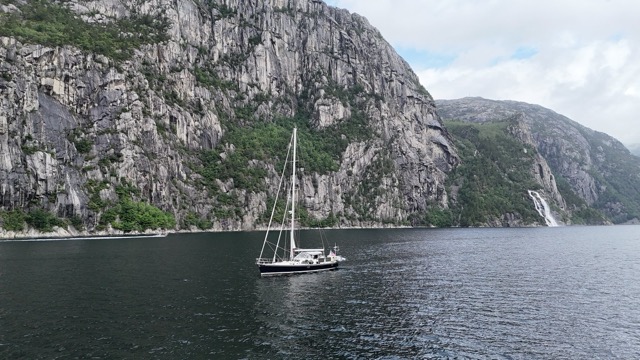

If the new regulations affect you, there are two tools you will need to use: the SafeSeaNet Norway (SSNN) website and the email address for CSC: csc@coss.mil.no.
Signing up to use SafeSeaNet
The SafeSeaNet Norway (SSNN) website lets you create an account and self-register, but we quickly ran into a roadblock—you can’t create a voyage plan until your vessel is entered into the system.
Fortunately, their tech support is excellent, both by phone and email. We contacted them at support.ssnn@kystverket.no with our boat details, and they manually added Naboo to the system. After that, we were able to start creating voyage plans.
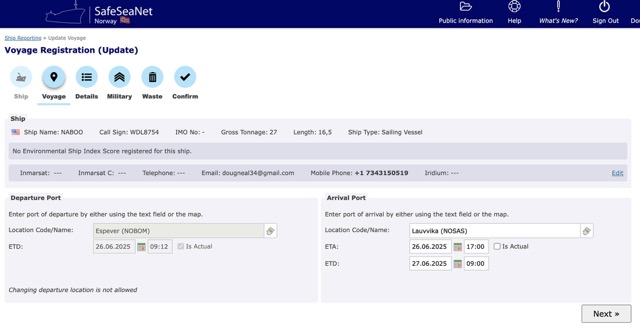

Log Every Arrival and Departure
Before you sail or motor anywhere in Norway, you must file a report in SSNN each time you leave a port or anchorage or arrive at a new destination.
This includes a voyage plan that spans approximately five pages of forms, covering details such as ship information, crew, ETA, ETD and other relevant information. It’s not difficult to do, but it does require time and the form is specifically designed for commercial ships. (Get ready to skip over fields about cargo, waste tanks and oil spill response plans.) I usually fill out the form in the cockpit while the engine is warming up, before casting off the lines. It takes me about three minutes now that I’ve gotten the hang of it, but the first time, prepare for a frustrating 20 minutes.
After departing, return to the voyage plan you just created and replace the ETD date and time from your last location with the actual departure time. Then, save the form. This only takes a minute.
Anchoring Requires Permission
Before you drop the hook, you must email csc@coss.mil.no and request permission to anchor. In this email, include your destination anchorage, the GPS position of that anchorage, ETA, ETD and purpose. They’ll usually respond quickly, but it’s a mandatory step. The response typically comes back in under two hours, sometimes within 30 minutes.
While at anchor, you’re also required to check in every 12 hours with your location and status. We accomplish this by setting an alarm for 12 hours and then sending a follow-up email with our status update.
Before you leave the anchorage, you’ll need to create a new voyage plan via SSNN and follow the same steps as above for logging arrivals and departures.
Starlink Makes It Easier
If you’ve got Starlink onboard like we do, reporting isn’t too painful. We’ve been able to submit reports and send anchoring emails easily from the cockpit, with no need to hike up a hill for a cell signal.
Still, it’s a task that adds a little administrative friction to an otherwise magical cruising ground. You don’t want to forget it; this is military oversight, not a courtesy call at the marina.
Advice for Other Cruisers
- Register your boat and get familiar with the reporting forms before you need to use them. The process is a bit clunky at first, it’s clearly designed for commercial shipping, so it’s much easier to navigate when you’re not under pressure.
- Create a template email to streamline anchoring check-ins.
- Bookmark SSNN and log in before you sail so you’re ready to file on the go.
- Don’t worry about the commercial shipping fields in the form; fill in the information that applies to you and leave the rest. The only exception is the Port Waste Management Plans page, which has fields that cannot be skipped. The Norwegian officials we spoke to said we can fill out fictitious waste information to get past it, which we do each time.
That’s it! Not a huge burden and worth the minor inconvenience to see so many beautiful anchorages and harbors!
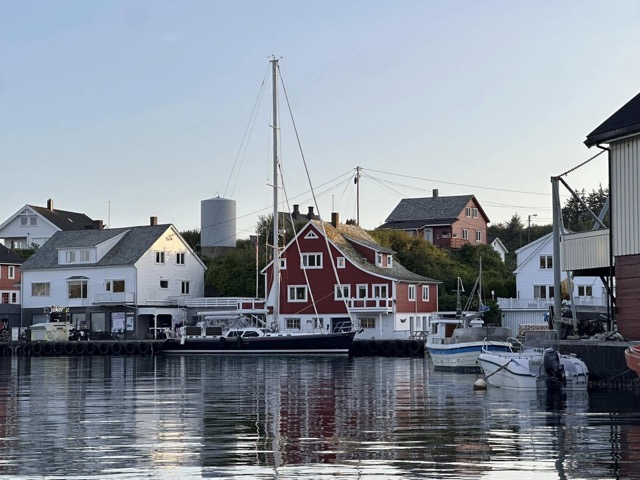

Additional Information
Something changed in the reporting process when we entered the waters of southern Norway. It’s unclear whether this is due to a change in the website, the amount of time we’ve spent in Norway, or the proximity to Oslo, but we now have to fill out the Military tab on each report.
This section requires us to enter exact GPS coordinates for both entering and exiting Norwegian territorial waters, even if our actual route never comes close to the border. In addition to providing starting and ending locations, we must now include two territorial GPS points with timestamps: one before departure and one after arrival.
It’s definitely confusing, but this workaround seems necessary to successfully submit the form.
Doug Neal
Sailing Naboo
Rubicon 3 Adventure – SV Bluejay
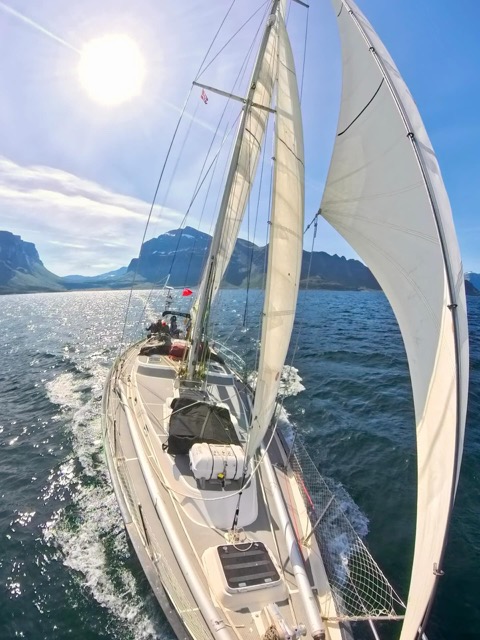

Registering with SafeSeaNet
Registering with SafeSeaNet (SSN) was simple. I emailed support.ssnn@kystverket.no, sent over our registry document, call sign and MMSI number. They added us to the system and once I created an account, I could find Bluejay in there.
Submitting Anchoring Requests to CSC
It’s been fairly straightforward. We run Starlink onboard and mobile phone coverage in Norway is generally excellent, so there’s no stress in emailing in. Our approach has been to send a sailing plan covering the next three to four days, including intended anchorages, and request approval on that basis.
You only need to seek approval for anchorages. As far as I can tell, they’re not interested in being notified about berthing in marinas or small Norweigan Harbours.
They state they’d prefer at least 24 hours’ notice for approving anchorages, but on one occasion I submitted a request in the morning and received approval within 2.5 hours.
We asked for a waiver from the requirement to report every 12 hours while at anchor (since we have AIS), but were told no. So the process is: get anchorage approval, notify when you anchor, report every 12 hours that you’re still at anchor, then notify when you weigh anchor.
While all of this can technically be done through the “Sailing Plan” section in SSNN, the interface isn’t small boat friendly at all and is clearly built for larger commercial vessels. Emailing or calling is much easier.
Using the Dinghy
At the same time as requesting anchorage approval, I’ve also included a note requesting permission to use the RIB to bring people ashore. So far, I’ve always received approval for both the anchorage and shore leave in the same reply.
The more onerous bit is that they ask you to send an email each time you go ashore and again once everyone is back onboard. CSC has never replied to these emails, but the instruction remains. You’re also told to inform the local police when going ashore, but they often sound utterly confused when you call. They don’t seem to be aware of this requirement.
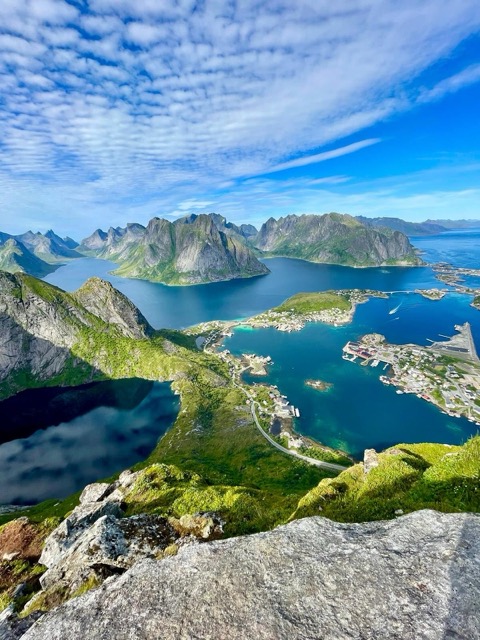

Advice for Other Cruisers
Try to prepare a comprehensive sailing plan covering several days. That way, you can secure the bulk of approvals in one go and reduce your admin load. The reality is that this is a bit of bureaucratic faff rather than any real hardship.
All the Norwegians involved have been incredibly friendly and understanding, recognizing that this is a slow rollout and that people are figuring it out as they go.
Ollie Bowden
Rubicon 3 Adventure
SV Bluejay
Anonymous Cruiser Submission
We sailed to Norway last year and these new reporting regulations did not exist at the time. When we began sailing this year, we didn’t know that we had to register our vessel (length 16.5m, German flag).
In Bergen harbour we were asked by e-mail to fulfil our obligation by registering with SafeSeaNet, which we didn’t understand at first.
Notifications to CSC
The entire course of a holiday voyage does not have to be notified, but each individual ship movement outside a harbor area must be notified the day before. The notification can be made informally by e-mail. (We did not register or use SafeSeaNet Norway.)
The ETD and destination with ETA are expected. The journey then begins the next day and immediately after arrival at the destination, the new departure time is expected to be communicated by e-mail. At this point, you are not expected to specify a new port of destination if you stay longer than 1 day.
As soon as you have decided where to go on the next leg, another e-mail will be sent to CSC with ETD, new port of destination and ETA. If the itinerary changes or there are major time deviations, this must be communicated by e-mail.
CSC does not respond or confirm that they have received the emails, but if a message is missing, you will be asked to submit it immediately.
Anchoring and Dinghy Use
The use of dinghies and anchoring maneuvers must be announced at least 24 hours in advance (this does not apply in emergencies). The exact position must be specified, not just the general area, along with the planned time.
This rule is impractical for recreational boats. It may be possible to obtain permission to anchor more quickly in urgent cases. However, we have not attempted this.
These maneuvers may only be carried out if they have been confirmed in writing from CSC by e-mail.
Position Reports
In addition to being available by e-mail and telephone, it is necessary to keep the AIS running 24/7. If this is not possible, the exact location must be communicated by e-mail every 6 hours.
Coast Guard Check
We were stopped and checked by the police and coast guard in a fjord (passports, ship documents and alcohol). Everything was in order. They were very polite and friendly and even expressed their incomprehension about this new reporting requirement. We were told that the checks would probably not be so strict.
Official Warning
Two days later, we promptly received an official warning by CSC as an attachment to an email, stating that we had submitted our last report two hours too late. We were told that if we continued to disregard the rules, we would have to pay a fine and would be expelled from Norwegian waters.
We had to officially confirm receipt of this warning.
Anonymously Submitted
………………………………
Noonsite thanks our contributors for their useful reports from Norway. If you have an experience that you would like to share and would like to be added to this report to let other cruisers know how it is going, please send us your report to editor@noosite.com or add to the comments on this report.
…………………………………
About the Authors
Sailing Naboo
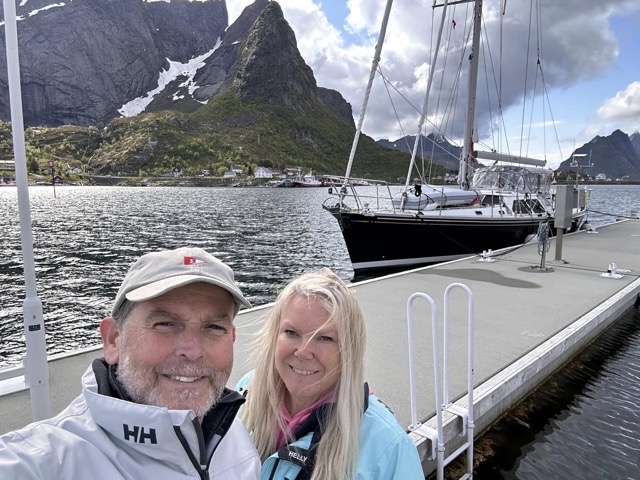

Doug and Angelique Neal are lifelong sailors and members of the Great Lakes Yacht Club, with over 30 years of sailing experience and more than 10,000 nautical miles traveled together. Their adventures span the U.S. West Coast, the Great Lakes, the East Coast from Florida to Nova Scotia and multiple transits of the St. Lawrence Seaway.
In 2024, they achieved a significant milestone in their planned Atlantic circumnavigation by crossing the North Atlantic from Nova Scotia to Ireland via the Azores. Their 2025 journey took them through the Orkney and Shetland Islands, across the North Sea to Norway, above the Arctic Circle to Tromsø and the Lofoten Islands and down the Norwegian coast to Oslo and then Sweden.
Their boat, Sailing Naboo, is a 2007 Hylas 54, which was purchased with the specific goal of crossing the Atlantic. She is a 27-ton center cockpit cutter rig with a partially skegged rudder.
Rubicon 3 Adventure
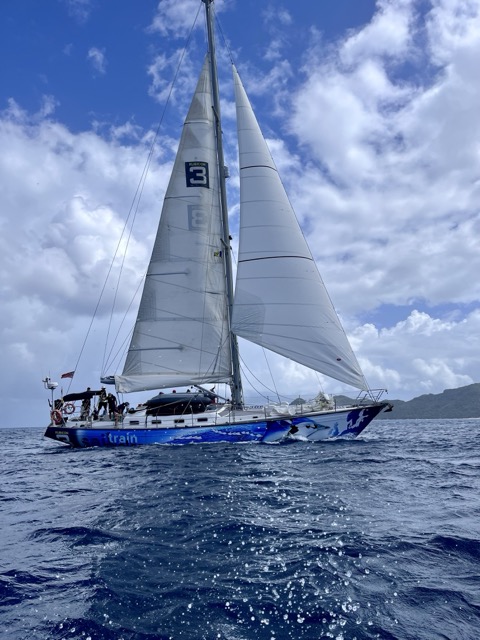

Ollie Bowden is the head of operations at Rubicon 3 Adventure. Rubicon 3 is a UK-based sailing company focused on proper adventure sailing and building real skills. Rubicon 3 runs offshore training, ocean crossings, and expedition voyages all over the world, mixing solid seamanship with a healthy dose of exploration. Whether you’re just starting out or already have miles under your belt, it’s all about getting stuck in, learning loads, and going somewhere extraordinary.
This season Rubicon 3 had two sailing vessels operating in Norway – SV Bluejay and SV Hummingbird. Both vessels are Clipper 60 (18.3m), cutter rigged sloops.
…………………………………
Related Links:
- Norway: New Yacht Reporting Requirements – Noonsite News Article about the changes
- Regulations on Foreign Vessels’ Entry into and Navigation in Norwegian Territorial Waters – the English translation of the new regulations, in full, from the Norwegian government
- Guide for Foreign Captains from the Norwegian Armed Forces – the military issued summary of the new, stricter reporting requirements
- Norway Clearance – Noonsite’s page with all the Clearance details for Norway for recreational vessels of all sizes
- Sailing Naboo – Facebook Page
- Rubicon 3 Adventure – Website
…………………………………
© 2025 Noonsite. This content was edited by Noonsite. Do not reproduce without permission. All rights reserved.
The opinions expressed in this article are the author’s own and do not reflect the view of Noonsite.com or World Cruising Club.
Find out all news, reports, links and comments posted on Noonsite, plus cruising information from around the world, by subscribing to our FREE monthly newsletter.
Related to following destinations: Alesund, Bergen, Bodo, Egersund, Farsund, Floro, Fredrikstad, Hardbakke/Solund, Harstad, Haugesund, Kristiansand, Kristiansund, Lillesand, Maloy, Mandal, Molde, Moss, Norway, Oslo, Rosendal, Stavanger, Stord, Tananger, The Skagerrak (South & East coasts), Tonsberg, Tromso, Trondheim, West Coast (north of Lat.64), West Coast (south of Lat.64)
Related to the following Cruising Resources: Anchorages, Arctic, Atlantic Ocean East, Cruising Information, Cruising Permits, Documents, Documents Required, General, Navigation, Off the Beaten Path, Other Considerations, Planning and Preparation, Routing
Related to the following Services, Goods and Amenities: Clearance



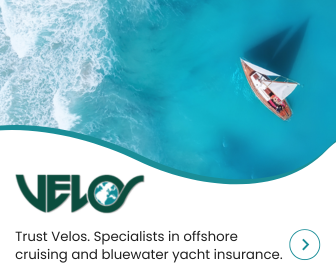
I don’t see any good reason to sail to Norway with all this periodic red tape, they are making it very clear we are not welcome by putting all the new rules in place and the nonsense with the dinghy needing permission to move it anywhere. hard pass.